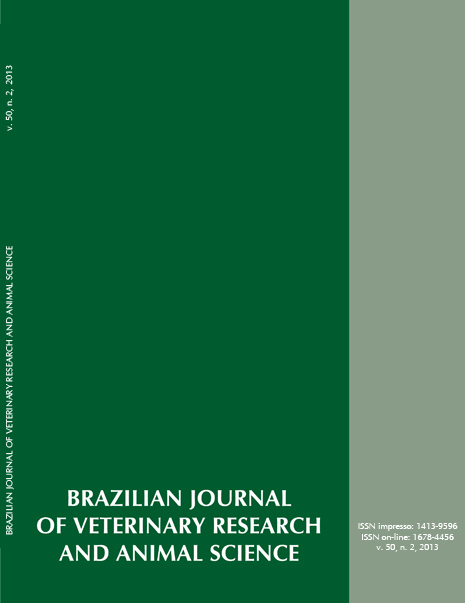Seroepidemiology of sheep brucellosis in the microregion of Feira de Santana, BA, Brazil
DOI:
https://doi.org/10.11606/issn.2318-3659.v50i2p129-135Keywords:
Brucella ovis, Risk factors, AGID, Occurrence, SerologyAbstract
The aim of the present study was to perform a seroepidemiological survey of Brucella ovis in ovine flocks in the microregion of Feira de Santana, State of Bahia (BA), Brazil. Ten municipalities with the largest sheep flocks were selected for this survey: Antonio Cardoso, Feira de Santana, Ipecaetá, Ipirá, Itatim, Pintadas, Rafael Jambeiro, Santa Teresinha, Santo Estévão and Serra Preta. The sample size was established on the basis of three parameters: significance level (99%), sampling error (5%), and estimated prevalence (50%). The total sample was divided proportionally to the sheep population found in the respective municipalities. The flocks examined in each municipality were randomly selected. The animals were older than six months and were distributed among 49 properties in the municipalities. Samples of blood from 793 male and female sheep were analyzed. During visitations, an epidemiological questionnaire was applied for collection of information and analysis of possible risk factors. All sera samples were analyzed by agar gel immunodiffusion (AGID) and the antigen was a mixture of soluble proteins and lipopolysaccharides from B. ovis (strain Reo 198). Seropositive animals (6.94%, 55/793) to B. ovis were detected. However, significant statistical difference (p>0.05) was not found for age and sex. Risk factors that might be associated with cases of seropositive animals for the variables analyzed were not found. In 61.22% (30/49) of the examined farms at least one seropositive animal was detected. Only two of the ten municipalities above had no seropositive animal.
Downloads
Downloads
Published
Issue
Section
License
The journal content is authorized under the Creative Commons BY-NC-SA license (summary of the license: https://





